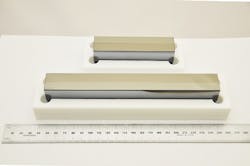Multilayer optics manufacturer Rigaku Innovative Technologies (RIT; Tokyo, Japan) can now clean and recoat old synchrotron optics to either retask the optics for new applications or to refurbish and repair the coatings to enhance performance. This proprietary process restores the optics’ performance with less lead time and at a far lower cost than purchasing new optics. The company also offers new optics and coatings for synchrotron applications that have high reflectivity and precision.
RELATED ARTICLE: Home-grown ARPES spectroscopy system substitutes for synchrotron light source
Synchrotron beamline end stations and analytical instruments most often operate with high-intensity X-rays. Such high-intensity beams can result in damage to single-film and multilayer coatings. Because synchrotron and similar custom-made optics typically require extremely precise coatings on premium quality substrates, these substrates and coatings can be very expensive and require long lead times.
RIT has developed a proprietary methodology for the refurbishment, recovery, and restoration of synchrotron optics systems. Rigaku's refurbishment method is designed to reduce costs and lead time for the setup of experimental and analytical equipment, as well as beamline end stations. Additionally, the process restores damaged multilayers to the same quality and performance as new multilayer optics.
Optical refurbishment is an effective and efficient solution to address the major challenges experienced in synchrotron applications. The process provides: recovery of optical performance by removing the damaged multilayer or single film and re-depositing a new coating; removal of contaminants without damaging the underlying multilayer structure and preservation of the original high quality substrate surface without the need for re-polishing. The process allows for maintenance of low micro roughness on any scale, from low spatial frequency roughness to high spatial frequency roughness. The process can restore some damage to high spatial frequency roughness. If the optic is too damaged in any roughness scale, mechanical repolishing may still be required.
RIT also manufactures new synchrotron optics, with high reflectivity and high precision coatings available on mirrors up to 1.5 m long. These coatings can be single-film, bi-material, or tri-material multilayers, with protective top coats and adhesion layers available. RIT is capable of producing optics with coatings in narrow stripes to allow multiple material systems, as well as multiple d-spacing films coated on the same optic. Additionally, the company produces double multilayer monochromators on optics up to 1.5 m long. In these applications, substrates such as Si<111> and other natural crystals can form one stripe of the monochromator.
SOURCE: Rigaku Innovative Technologies (RIT); http://www.rigaku.com
About the Author

Gail Overton
Senior Editor (2004-2020)
Gail has more than 30 years of engineering, marketing, product management, and editorial experience in the photonics and optical communications industry. Before joining the staff at Laser Focus World in 2004, she held many product management and product marketing roles in the fiber-optics industry, most notably at Hughes (El Segundo, CA), GTE Labs (Waltham, MA), Corning (Corning, NY), Photon Kinetics (Beaverton, OR), and Newport Corporation (Irvine, CA). During her marketing career, Gail published articles in WDM Solutions and Sensors magazine and traveled internationally to conduct product and sales training. Gail received her BS degree in physics, with an emphasis in optics, from San Diego State University in San Diego, CA in May 1986.
